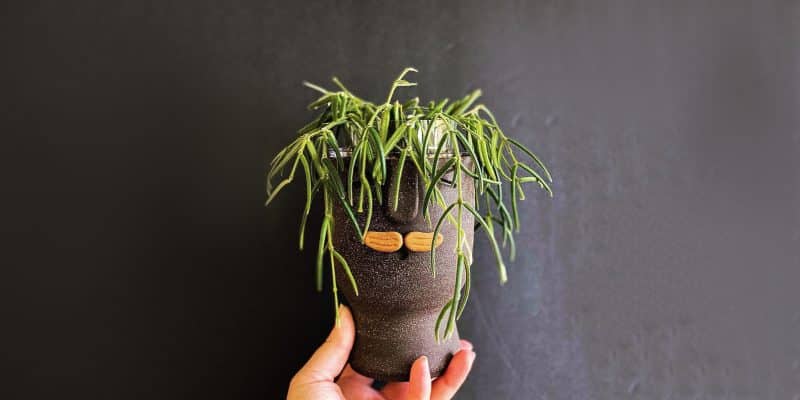With its fuzzy, succulent-like leaves and waxy, star-shaped flowers, you’ll be glad you added Hoya Linearis to your houseplant collection.
It’s not a fussy plant, but one as stunning as this does come with its own unique set of care requirements.
Worry not, for we’ve crafted the ultimate Hoya Linearis care and growing guide just for you. Together, we’ll explore its preferred environment, from lighting, water, and temperature to soil, propagation, and how to solve common issues.
(Bonus: When allowed to grow down thick like a curtain, it’s stunning as a hanging plant!).
Table of Contents
Hoya Linearis Care Guide
History, Habitat, and Characteristics
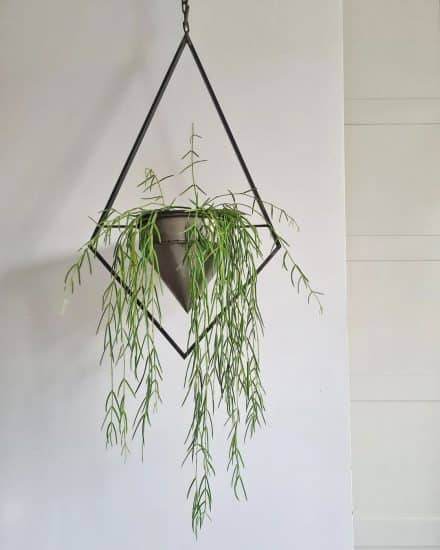
Originating from the Himalayas and China, Hoya Linearis grows in forests and among rocky cliffs. A subtropical epiphyte belonging to the Apocynaceae family, this trailing plant features long, needle-like leaves with tiny hairs that function to conserve water in the plant’s native habitat.
Hoya Linearis belongs to the larger group of hoya plants, and is therefore commonly called “wax plant,” like its popular cousin, Hoya carnosa, which features glossy, waxy leaves that give it its name. With fuzzy, long leaves, though, this particular hoya plant hardly resembles a typical wax plant.
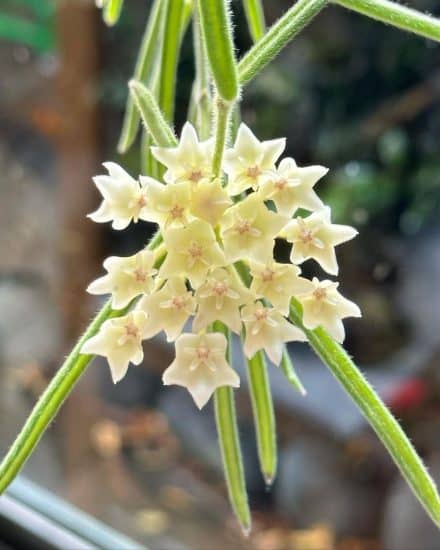
The star-shaped flowers that hoyas are famous for are unmistakable, though. Like other hoya varieties, Hoya Linearis produces clusters of white flowers, but you’re unlikely to see them until the plant is mature, about 3 to 5 years old. When it does bloom, you may notice the flowers emit a faint lemony scent.
Light
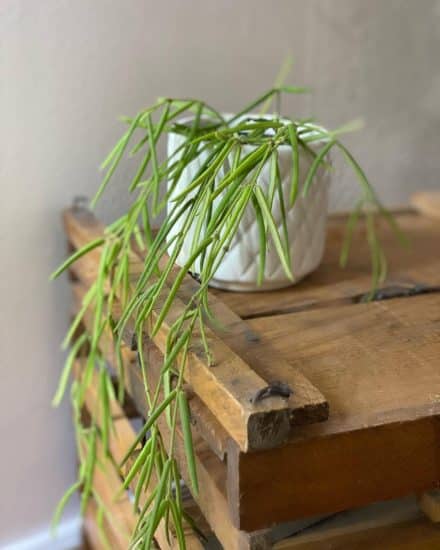
Hoya Linearis light requirements are pretty easy. It loves medium to bright indirect light and can even handle some direct light in the early hours of the morning. A few feet from a south- or west-facing window is perfect for this plant’s growth.
You might find that an east-facing window doesn’t give enough consistent bright light throughout the day.
If you notice pale or yellow leaves, weak growth, or a lack of flowers on a mature plant, your hoya might not be getting enough light. Move your plant to a brighter window or try incorporating an artificial grow light (full-spectrum LED is our top pick).
Can your Hoya Linearis get too much light? It sure can. In a very sunny spot, the leaves may look shriveled and sun-bleached or develop small holes or brown edges. If that’s the case, it’s time to move it away from the window or add a sheer curtain to filter out intense rays.
Our lighting tips:
- Position your Hoya Linearis in indirect, bright sunlight.
- Avoid excessive direct sunlight, which can scorch the leaves.
- Use a sheer curtain to diffuse direct light.
- Add an artificial light if your plant doesn’t have enough light.
Water
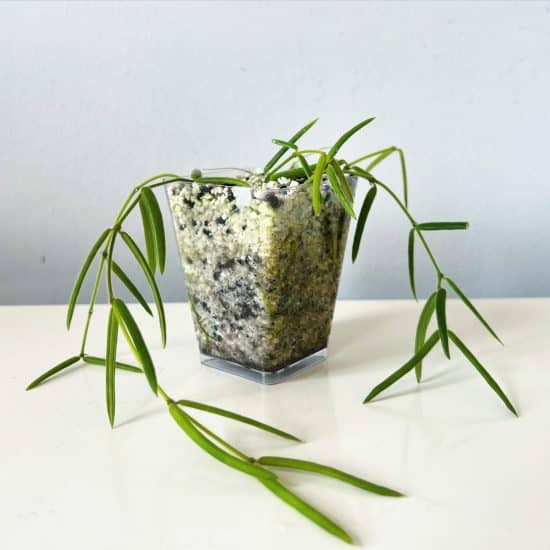
Growing Hoya Linearis can be a bit tricky because it doesn’t like being too dry or too wet. It’s kind of like Goldilocks that way, only satisfied when the conditions are just right.
It’s a bit thirstier than its cousin, Hoya carnosa (also known as the wax vine or porcelain vine), but it’s not all that greedy for water, either. Instead of watering your plant regularly, it’s best to let it tell you when it’s thirsty.
Check the soil with your finger, and when the top 2 inches are dry, it’s probably ready for water.
Another way your plant will tell you it needs water is through its leaves. Give the leaves a little “squish test.” If they feel firm and plump, it’s not ready for water.
But if they’re starting to soften up or thin out, it needs a thorough drink. Water enough that the water flows through the drainage holes, then wait for it to dry out again.
Insufficient water can make your Hoya Linearis look sad and wilted. You’ll notice its leaves getting softer and the plant losing its perky appearance.
If this happens, pick up the pace with your watering routine. And don’t forget to remove any dead or dried stems to keep your plant happy and pest free.
But don’t give it too much water, even if it’s been thirsty. Overwatering is the most common way to kill a houseplant because it drowns the roots and deprives them of necessary oxygen.
Yellow leaves and mushy stems are surefire signs that you’ve gone overboard. If you see this happening, cut back on the watering and let the soil dry out a bit.
Our watering tips:
- Water when the top 2 inches of soil is dry.
- Pay close attention to the leaves for signs of under- or overwatering.
- Water thoroughly when dry, allowing water to flow from the bottom of the pot (it should have at least one drainage hole!).
Temperature and Humidity
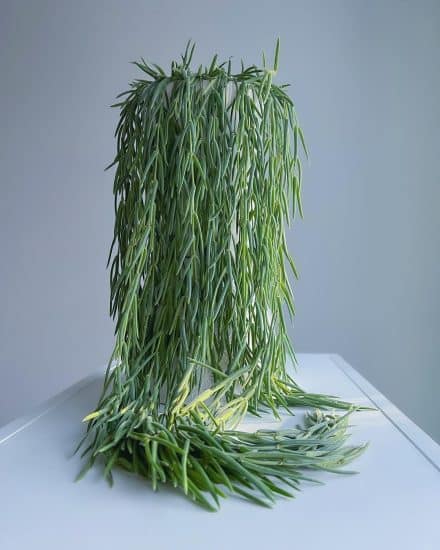
Hoya Linearis can adapt to a variety of climates, but it’s native to regions where it doesn’t stay hot year round, so it appreciates cooler nighttime temperatures. Aim for moderate temperatures of 60-80°F (15-27°C) throughout the day for optimal growth.
It’s important to protect your plant from extreme temperature fluctuations, such as cold drafts or direct exposure to heating vents. To avoid exposing it to a temperature Hoya Linearis might not appreciate, consider moving it away from windows or doors that are frequently opened and closed.
Humidity is another crucial factor for Hoya Linearis’ well-being. This plant does well in a humidity level between 50% and 60%. If there’s not enough humidity for your Hoya Linearis plant, you might notice the leaves becoming dry or curly.
To increase humidity around your Hoya Linearis, place it on a tray filled with water and pebbles, or consider using a humidifier. A regular light misting of the leaves won’t hurt, but it isn’t an ideal solution for raising humidity levels long-term. You’d have to mist every day for a long time for misting to be effective, which just isn’t practical.
If you do decide to incorporate a humidifier, do so incrementally and start on the lowest setting. If local humidity gets too high, your plant may experience mold or mildew growth.
Soil and Planting
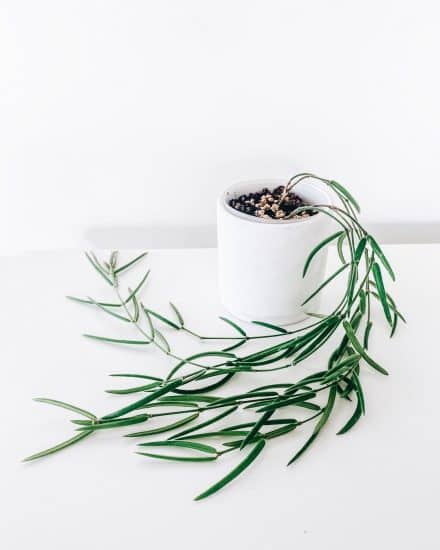
Hoya Linearis grows best in a well-draining and airy potting mix that allows its roots to breathe, like a premade cacti soil.
Successful potting mix combinations include coconut coir and perlite, which add moisture retention and aeration, respectively. Some people even add orchid bark to the mix for further aeration.
If you notice your Hoya Linearis exhibiting yellow leaves or suffering from weak growth, it could be a sign of poor soil conditions. A compacted or heavy potting mix can suffocate the plant’s roots and stunt growth.
To rectify these issues, repot your plant in an airy, well-draining potting mix.
Hoya Linearis plants don’t require frequent repotting. In fact, they don’t mind being slightly root bound. When it’s time for a change, though, choose a pot only slightly larger than the current one, and ensure it has proper drainage holes.
Spring and summer are ideal for repotting, when the plant is actively growing and better able to handle the stress of being moved.
When repotting, be careful not to pack the potting mix too tightly around the root ball. This can compact the soil and impede oxygen flow to the roots, potentially causing root rot.
Fertilizer
For optimal growth and health of your Hoya Linearis, fertilize only during the growing season, in spring and summer. Adding slow-release fertilizer pellets to the potting mix gives it the nutrients it needs on a consistent basis.
Alternatively, use a liquid houseplant fertilizer when you water and follow the dilution directions on the label.
If your Hoya Linearis starts to exhibit symptoms like leaf burn, a buildup of fertilizer salts on the soil surface, or stunted growth, it may be a sign of over-fertilization. Flush the soil with water to remove excess fertilizer salts.
Make sure to follow the recommended fertilization schedule and dilution rates on the label to prevent future over-fertilization issues.
Propagation Guide
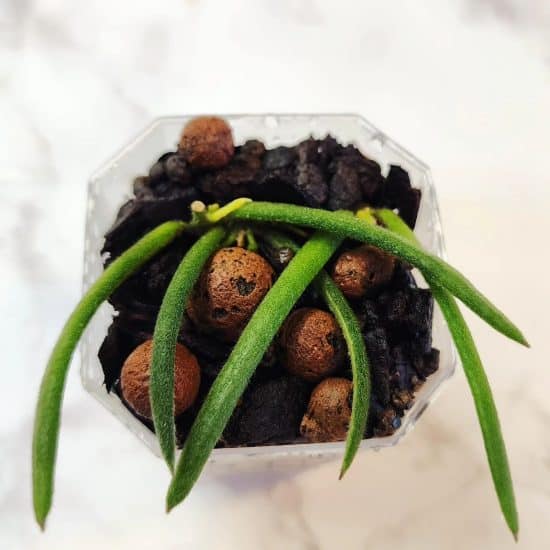
Hoya Linearis propagation is easy with stem cuttings. Plus, cutting stems encourages bushier growth and new growth points on the mother plant.
Propagating Hoya Linearis by stem cutting:
- Snip a stem cutting: Grab some sterilized gardening shears and cut a section from the main stem of the plant. Aim for a two-node cutting, meaning you want at least two leaf nodes on it. This boosts your chances of propagation success. Make your cut just below a node for the best results.
- Get your cutting ready to grow: Gently remove any leaves from the bottom node to help it focus on rooting. This also keeps the submerged leaves from decaying in the water.
- Root stem cuttings in water: Submerge the nodes in a small container filled with filtered water. Don’t forget to change the water every few days and place it in a spot with bright, indirect light to ensure the best environment for rooting stem cuttings. (Optional: Dip the ends in rooting hormone before this step.)
- Keep an eye out for roots: Over time, you’ll spot new roots emerging from the nodes. Let these roots grow until they’re about 1-2 inches long.
- Plant in potting mix: Now that your Hoya Linearis cutting has roots, it’s time to transfer it to a pot filled with a well-draining potting mix. You can either plant the cutting back in the original pot with its parent plant or in a separate pot. Water the cutting regularly and make sure it gets the light and humidity it needs to flourish.
Common Issues
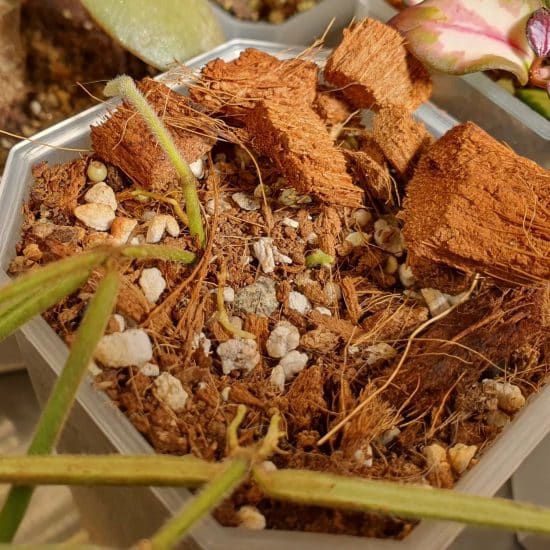
As with all houseplants, Hoya Linearis might fall victim to a few common issues, but don’t worry, we’re here to help you tackle them like a pro.
Plant Dropping Leaves
Sudden leaf drop in Hoya Linearis is probably a sign of a water issue — either too much or too little. Remember that your hoya will require less water in winter than in summer. It’s fine to let your Hoya linearis plant dry out completely during the winter.
To solve this problem, inspect your care routine and make sure you’re following our guidelines carefully. Make sure it’s getting enough light, but not too much sun, and that the soil is allowed to dry out a bit, even during the growing season.
Yellowing Leaves
Yellow leaves on your Hoya Linearis can indicate a number of issues. To solve this mystery, first inspect the potting medium. If it’s so dry that the soil feels hard and is separating from the side of the pot, your plant needs more consistent watering. If it’s continuously wet, you might be drowning the poor thing!
Another reason for yellow leaves may be insufficient nutrients. If you’re certain your watering is on point, you might need to feed your plant.
A well-balanced fertilizer diluted in water may do the trick, but you could also mix some compost into the top inch of soil. This has the added benefit of improving soil texture as well as adding nutrients.
Pests and Diseases
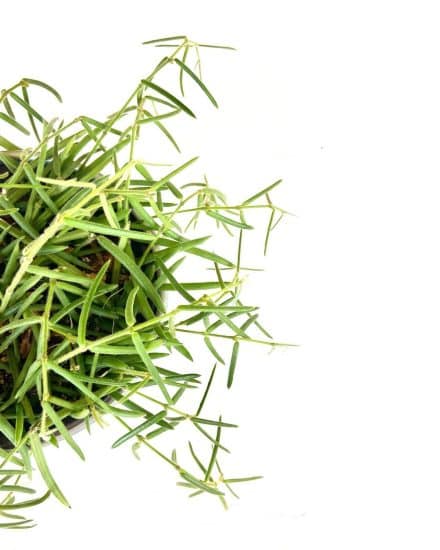
Mealybugs and Ants
All right, Hoya Linearis has a bit of a weakness for mealybugs. These tiny pests hide in the nodes and behind the leaves. They look like small, cottony white blobs.
Now, you might also spot ants around. That’s because ants and mealybugs are, like, best buddies. Ants love to munch on the sugary honeydew mealybugs leave behind.
When you find mealybugs or ants, it’s time to take action! Grab a damp cloth or a cotton swab dipped in rubbing alcohol and gently remove those little buggers from the leaves and stems.
If they’re really making themselves at home, you might need to bring out the big guns — insecticidal soap or neem oil. Just follow the label directions, and you’ll be good to go.
To prevent future invasions, regularly inspect your Hoya Linearis and keep it away from other plants that might be hosting these pesky little guys. Good airflow and proper watering can also help discourage them.
Root Rot
Now, root rot is a problem that many indoor plants face, and Hoya Linearis is no exception. When soil stays wet for too long, the roots can’t breathe, and they start to rot. You’ll see signs like yellowing and wilting leaves and a rotten smell.
To fix root rot and save your plant, gently remove your Hoya linearis from its pot and snip away any mushy, slimy, and discolored roots. Then, repot your plant in fresh, well-drained potting soil with some perlite, pumice, or LECA mixed in for better aeration and drainage.
Prevention is key, so when it comes to watering, wait until the top 2 inches of the potting soil is dry before giving your Hoya linearis a drink. Excess water buildup from a lack of drainage holes in the pot is the most common cause of root rot, so making sure the plant pot has proper drainage holes is absolutely essential.
Conclusion
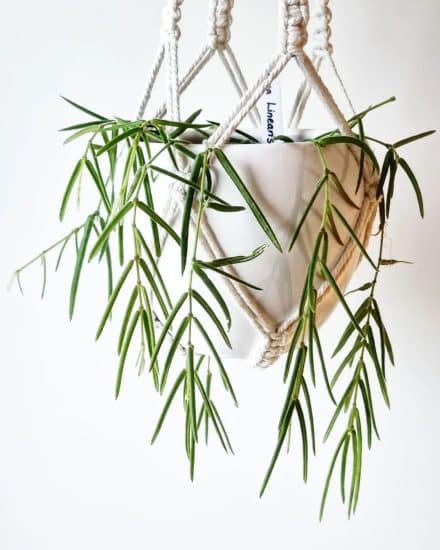
That’s a wrap on our Hoya Linearis plant care and growing guide! One of the most distinctive trailing plants you’ll find, Hoya Linearis looks like a burst of needles pointing downwards, but is a remarkably undemanding houseguest (houseplant?).
Hoya Linearis care summary:
- Provide medium to bright indirect light and some early direct sunlight.
- Water your Hoya Linearis lightly, ensuring the top 2 inches of soil is dry between waterings.
- Provide well-draining soil for happy roots.
- Aim for temperatures between 60-80°F and humidity levels between 50% and 60% to create the perfect environment for your plant.
- Fertilize with slow-release fertilizer pellets or a liquid fertilizer mix during the growing season.
- Propagate Hoya Linearis through stem cuttings.
We hope our comprehensive guide has given you the knowledge to grow Hoya Linearis with confidence! If you found this guide helpful, don’t hesitate to share it with fellow houseplant lovers.
As always, feel free to reach out to us with any questions that might come up. Happy planting!
FAQ
Is Hoya Linearis hard to grow compared to other hoyas?
Hoya Linearis can be a bit trickier to grow compared to other hoyas, but with the right care, it can thrive just as well. It has specific temperature, humidity, and light requirements that might require a bit more fine-tuning compared to, say, Hoya carnosa.
Is Hoya Linearis a succulent?
Although Hoya Linearis might look like a succulent with its light blue, fuzzy, and plump leaves, it’s not technically a succulent. It’s a part of the Hoya genus, which consists of around 700 species of flowering plants, hailing from the Apocynaceae family.
While it does share some similarities with succulents, such as the ability to store water in its leaves, it’s more accurately described as a semi-succulent or an epiphytic vine.
Is Hoya Linearis the same as string of needles?
Yes, Hoya Linearis is sometimes referred to as “string of needles” due to its long, trailing stems and thin, needle-like leaves. The nickname perfectly captures the plant’s delicate, cascading growth habit and makes it an apt choice for a hanging basket or elevated planter.
What is the difference between Hoya retusa and Hoya Linearis?
While both Hoya retusa and Hoya Linearis belong to the genus Hoya, and they each have unique growth habits and leaf structures that make them stand out from other hoyas, these two hanging plants do have notable differences.
Hoya retusa features thin, flat leaves with blunt ends, giving it a distinct grass-like appearance. Meanwhile, Hoya Linearis boasts delicate, needle-like leaves that grow along trailing stems, creating a beautiful cascading effect.
Hoya retusa and Hoya Linearis share similar care requirements, including well-draining soil, bright indirect light, and moderated watering schedules. However, Hoya Linearis is generally more sensitive to humidity levels, preferring a slightly more humid environment compared with Hoya retusa.
Is pruning Hoya Linearis important?
Pruning Hoya Linearis isn’t mandatory, but it can help maintain the plant’s health and promote bushier growth. Regularly removing dead or damaged stems and leaves can keep your wax vine looking fresh and pest free.
Also, by trimming long stems and encouraging the plant to branch out, you can achieve a fuller, more appealing appearance. Just make sure to use clean, sterilized shears to avoid spreading plant diseases to your Hoya Linearis.
Is Hoya Linearis toxic?
While Hoya Linearis isn’t toxic, the milky sap it produces can be irritating to pets and small children. It’s best to keep this plant out of reach for that reason.

